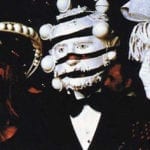 Technology
Technology  Technology
Technology  Our World
Our World 10 Ways Icelandic Culture Makes Other Countries Look Boring
 Misconceptions
Misconceptions 10 Common Misconceptions About the Victorian Era
 Mysteries
Mysteries 10 Strange Unexplained Mysteries of 2025
 Miscellaneous
Miscellaneous 10 of History’s Most Bell-Ringing Finishing Moves
 History
History 10 Great Escapes That Ended Right Back in Captivity
 Weird Stuff
Weird Stuff 10 Fascinating Things You Might Not Know About Spiders
 Food
Food 10 Everyday Foods You Didn’t Know Were Invented by the U.S. Military
 History
History 10 Odd Things Colonial Americans Kept at Home
 Weird Stuff
Weird Stuff 10 Superstitious Beliefs That Once Consumed Entire Cultures
 Technology
Technology 10 Scientific Breakthroughs of 2025 That’ll Change Everything
 Our World
Our World 10 Ways Icelandic Culture Makes Other Countries Look Boring
 Misconceptions
Misconceptions 10 Common Misconceptions About the Victorian Era
Who's Behind Listverse?

Jamie Frater
Head Editor
Jamie founded Listverse due to an insatiable desire to share fascinating, obscure, and bizarre facts. He has been a guest speaker on numerous national radio and television stations and is a five time published author.
More About Us Mysteries
Mysteries 10 Strange Unexplained Mysteries of 2025
 Miscellaneous
Miscellaneous 10 of History’s Most Bell-Ringing Finishing Moves
 History
History 10 Great Escapes That Ended Right Back in Captivity
 Weird Stuff
Weird Stuff 10 Fascinating Things You Might Not Know About Spiders
 Food
Food 10 Everyday Foods You Didn’t Know Were Invented by the U.S. Military
 History
History 10 Odd Things Colonial Americans Kept at Home
 Weird Stuff
Weird Stuff 10 Superstitious Beliefs That Once Consumed Entire Cultures
10 Times Relatives of Famous People Were Shut Away
In the past, people who had difficulty fitting into mainstream society because they were mentally ill or developmentally challenged were often hidden away in institutions or elsewhere by their families. Because of the stigma that was attached to psychiatric problems and intellectual disabilities, sometimes, the more prominent a person was, the more anxious they were to keep these relatives under wraps.
In other cases, asylums were recommended by doctors, limited in their ability to treat these conditions during less progressive times. However, fame often made it harder for these celebrities to keep secrets about their personal lives. Here are 10 of the most surprising stories about close family members of famous people being shut away.
Related: 10 Remarkable Tales Of Lost Relatives Who Resurfaced
10 Prince John
Today, details of Prince John, the epileptic and intellectually challenged youngest child of the former British monarch George V and Queen Mary, are much more accessible than they were during the early 20th century. In addition to his seizures—which began at the age of four—and his difficulty learning, he may have also been autistic. The dignified and reserved royal couple was extremely conscious of their public image. They worried that John’s condition would somehow reflect negatively on them and subsequently lessen their subjects’ faith in the royal family.
In 1913, when John turned eight, there was surprising news that John would not attend the same prep school as his older brother, Albert (the future George VI). There was a question of whether he would be sent to school at all. Around this time, John began to recede from public view and spent very little time with his parents, who were busy with wartime duties. He eventually became isolated from his siblings to save them from the trauma of witnessing his seizures, which he experienced with increasing frequency and severity over the years.
When John was 11, he was sent to live at a property called Wood Farm on the outskirts of the family’s Sandringham estate, where he was cared for by his nanny. Queen Mary arranged for local children to play with him, but he was secluded from visitors to Balmoral, who would see him from a distance in the woods. Prince John continued to live at Wood Farm until his death following a seizure at the age of 13.[1]
9 Cary Grant’s Mother Else
For many years, screen icon Cary Grant mistakenly believed his mother, Else Leach, was dead. In the mid-1930s, as the actor’s career was taking off, he was shocked when his father finally revealed the truth: Else was alive and had been living in a mental institution. At the time of Else’s sudden disappearance, when Grant was 11 years old, he was initially under the impression that his mother had gone for a rest at a seaside resort .and was later told that she had died.
This news traumatized the young boy and left lasting emotional scars. Actually, his father had sent Else, who was diagnosed with mania, to Bristol Lunatic Asylum, where she would remain for two decades.
When Grant learned of her whereabouts, he arranged for her release. Else, who did not immediately recognize him, was shocked to learn that her little boy had become a wealthy film star. The two had an understandably awkward but loving relationship over the years, and Grant took care of Else until her death in 1973.[2]
8 Prince Philip, Duke of Edinburgh’s Mother Princess Alice
Prince Philip’s eccentric mother, Princess Alice of Battenberg, sister-in-law of the late Greek monarch Constantine I, was less secluded while spending her final years at Buckingham Palace than viewers of TV series The Crown might think. However, many years earlier, while she and her family were in exile, Alice was diagnosed with schizophrenia. She was confined to a psychiatric clinic in Berlin against her will in the early 1930s when Philip was still a child.
When Sigmund Freud was consulted, he decided that the religious visions she was experiencing were caused by sexual frustration. He advised treatment that included killing off her libido by repeatedly X-raying her ovaries, which would induce early menopause.
What is just as surprising as her unconventional behavior is the fact that she was able to accomplish so much, despite the obstacles in her path. After two years in a Swiss clinic, she returned to Greece and embarked on a philanthropic life, founding an order of nuns and helping to save Jews during WWII. Even though she did not take vows, Alice continually wore a nun’s habit for the last two decades of her life.[3]
7 T.S. Eliot’s Wife, Vivienne
Vivienne Haigh-Wood Eliot has been credited as a major source of inspiration for her husband, poet/playwright T.S. Eliot. But she was just as well known for her emotional problems, which were the source of so much distress and led to the breakdown of their marriage. The cause of her mental illness is not known for sure. There has been speculation that she was bipolar or paranoid schizophrenic or that her erratic behavior was based on gynecologic issues.
In addition to being Eliot’s muse, Vivienne was also his collaborator and wrote published pieces of her own under pseudonyms. However, her mental health issues persisted, making it difficult for her to accept her husband’s decision to leave her. She stalked him and believed he had been kidnapped and replaced by an imposter. Vivienne’s brother, Maurice, reportedly with the cooperation of T.S. Eliot, finally committed her to a mental institution in 1938, where she died nine years later at the age of 58.[4]
6 Edith Rockefeller McCormick
The Rockefellers, the massively wealthy industrialist family, have produced some fascinating people over the years, including socialite and patron of the arts Edith Rockefeller McCormick. She was the daughter of oil tycoon J.D. Rockefeller. Along with the glamour, excitement, and privilege, there was also plenty of darkness and suffering in Edith’s life.
Following the death of two of her children and a lengthy illness of her own, Edith struggled with mental health issues, including severe depression and anxiety. In 1913, she checked herself into a Swiss clinic where she was treated by pioneering psychologist Carl Jung. In an interesting twist, Edith went from being a patient to a collaborator of Jung’s during her eight years in Zurich and underwrote his work.[5]
5 Erik Erikson’s Son, Neil
Considering Erik Erikson’s status as a renowned psychologist, his reaction to having a developmentally challenged child is a little surprising. In 1944, his wife Joan gave birth to their son, Neil, who was born with Down Syndrome. Erikson sent him away immediately and lied to their other children, telling them the baby had died at birth. Susan Erikson Bloland’s book In the Shadows of Fame: A Memoir by the Daughter of Erik Erikson discusses the “emotional turmoil” that resulted from this decision and how it almost destroyed her parent’s marriage.
Told that Neil was unlikely to survive more than a year or two due to his condition, Erikson followed professional advice to send him to an institution. However, Neil actually lived to be 21 years old.[6]
4 Albert Einstein’s Son, Eduard
The life of Albert Einstein’s younger son Eduard, from his first marriage, was marked by many ironies. Eduard, born in Zurich in 1910, was sickly as a child but was gifted enough intellectually that he seemed capable of following in his brilliant father’s footsteps as a great scientist before his mental decline made it impossible. Idolizing Sigmund Freud, Eduard was very interested in psychology and studied medicine at the University of Zurich, with plans to become a psychiatrist. But instead of becoming a doctor, Eduard would be a patient for most of his adult life.
By the age of 20, there were indications he had schizophrenia, which would later be confirmed. Following a love affair with an older woman, which ended badly, his mental health worsened, and he attempted suicide in his early twenties.
Eduard spent time in sanatoriums, which may have damaged him further, and eventually became a permanent in-house patient at the psychiatric clinic Burghölzli in Zurich. Albert Einstein made real efforts to help him over the years and stayed in touch with Eduard, but he was devastated by his son’s condition. [7]
3 Mary Todd Lincoln
Mary Todd Lincoln is almost as well remembered for her erratic behavior as she is for being the wife of Abraham Lincoln. Not only did she struggle with depression, but her spending was out of control, and she could often be volatile. Some historians believe the former first lady may have had bipolar disorder. Others have exposed theories explaining her condition that range from menstrual trouble to vitamin B12 deficiency to actual insanity. However, it is important to put her behavior in context. Mary Todd Lincoln may have had a privileged life, but it was far from easy.
She had to endure the loss of three sons and cope with the pressure of being married to the president of the United States during the Civil War. The fact that she did not get a reputation for being unstable until after Lincoln became president suggests her problems may have been circumstantial.
Ten years after her husband’s assassination, Mary Todd Lincoln was forcibly institutionalized following an insanity trial initiated by her last surviving son, Robert, who would be appointed the conservator of her estate. After four months in the asylum, she traveled overseas, where she was cared for by her sister.[8]
2 Rosemary Kennedy
While she was growing up, her family made an impressive effort to include the intellectually challenged Rosemary in the Kennedy clan and give her a similar childhood to that of her siblings. However, Rosemary was sent to an institution at the age of 23 following a botched operation that left her more severely disabled.
As a small child, it was discovered that Rosemary was learning at a slower pace than expected, and it soon became apparent she had developmental limitations. She was sent to various schools and made significant progress at a Montessori school in England, which she attended when her father, Joseph Kennedy, was ambassador to the Court of St. James in Britain. However, the outbreak of war prompted the family to return home, and Rosemary, who was always rebellious and strong willed, became more difficult to control.
In an effort to make her more docile, Joe Kennedy arranged for her to have a lobotomy, but it turned out very badly, leaving the young woman “with a mental capacity of a toddler,” according to People. Rosemary was sent to a psychiatric facility in upstate New York and later Saint Coletta in Wisconsin, but her whereabouts were kept secret, even from her own siblings, for many years.
Rosemary’s closest sibling, Eunice, became a strong advocate for people with intellectual disabilities, founding the Special Olympics in 1968. Her brothers—the future President John F. Kennedy and Senator Ted Kennedy—worked to help disabled people, leading to the passage of the Americans with Disabilities Act in 1990.[9]
1 Zelda Fitzgerald
The most famous and celebrated literary spouse of the twentieth century, and maybe of all time, was Zelda Fitzgerald. The ultimate flapper, she and F. Scott Fitzgerald—author of such classic books as The Great Gatsby—were a colorful, fast-living couple who became synonymous with the Roaring Twenties.
Unfortunately, the extravagant lifestyle of Scott and Zelda took a big hit following the stock market crash of 1929, which left them in financial ruin. Soon after, she was diagnosed with schizophrenia. Zelda spent the next 18 years in and out of mental institutions, dying in a 1948 hospital fire at a facility in Ashville, North Carolina, at the age of 47.
There’s more to Zelda’s legacy than her role as a flamboyant but doomed muse. Like a lot of women married to creative men during this time, she was his uncredited collaborator. She was also the mother to F. Scott Fitzgerald’s only child, Frances, and was accomplished in her own right. In addition to her talents for painting and dancing, Zelda was a prolific writer, penning numerous magazine articles as well as novels and a play based on her turbulent marriage.[10]








